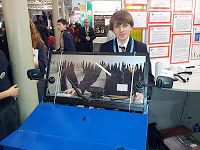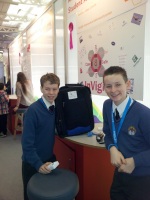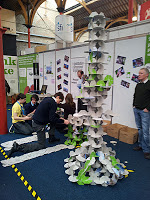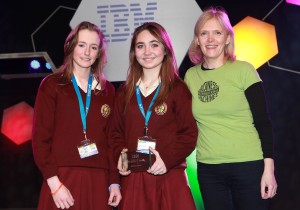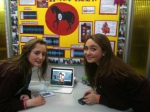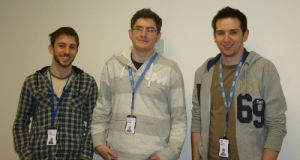Can IBM help with your entry to the BTYSTE Primary Science fair February 6, 2012
Posted by bodonovan in IBM, Smarter Buildings, Smarter Enegry, Smarter Healthcare, Smarter Transport.comments closed
IBM has a strong culture of encouraging employees to volunteer to help organisations in their community. For example, you can visit this site to read what we did during our centennial year. One of our recently launched programs is a scheme where IBM employees help local schools do projects relating to IBM.s Smarter Planet initiative.
Some people think that young children will have trouble understanding what is involved with our Smarter Planet initiative, but we find that with a little assistance, they have no trouble in getting involved. To see how this might work, look at the video below which features an interview with some pupils from Mount Sackville primary school about a Smarter Energy project that they carried out for this years primary science fair with assistance from IBM employees.
We would like to grow this type of partnership between IBM and local schools. If any schools are interested in doing a project for next years primary science fair and would like to get a member of IBM staff to come an help them with their project, please leave a comment on this blog and we will see if we can make arrangements. Naturally we are more likely to be able to help if the IBM volunteers live near the school, but if you don’t ask you will never know.
[xpost] Delighted to see the enthusiasm for science from the participants at the PrimaryScience fair January 26, 2012
Posted by bodonovan in Smarter Enegry, Uncategorized.comments closed
[This post was originally posted on Brian’s personal blog]
Sometimes people complain that the current generation of young people are losing their interest in and enthusiams for Science Technology Engineering and Maths (STEM). However, anyoine who visited the Primary Science fair at the Young Scientist Exhibition in the RDS this week could not possibly believe that these complaints are true.
Yesterday, I was scheduled to help demonstrate the Watson system at the IBM stand in the afternoon, so I came to the RDS early and spent the morning wandering around the exhibition. The first sction I visited was the PrimaryScience sectioon and the enthusiasm and energy of the young pupils demonstrating their work was wonderful to see. They were clearly very enthusisatic about their projects and rightly proud of what they had done.
All of the project were great, but the highlights for me were:
 The Mount Sackville project “Smart Energy” which looked at ways that the girls could be less wasteful of electricity both in school and at home. Of course I am biased by the fact that I was involved in launching this project, but the reality is that I had relatively little to do with the project.
The Mount Sackville project “Smart Energy” which looked at ways that the girls could be less wasteful of electricity both in school and at home. Of course I am biased by the fact that I was involved in launching this project, but the reality is that I had relatively little to do with the project.
Once I introduced the girls to the topic they embraced the it with great enthusiasm and did not require much help. They used the current cost meters that I had set up for them to chart enetric usage and they summarised it in some wonderful charts. They also came up with great ideas for how they could be more effecient.
I was also pleasantly surprised to see how prominently they acknowledged the help they got from IBM. The boys who were presenting the Unlimited Energy stand had built a number of different devices that showed different forms of energy being applied. Unfortunately I didn’t record the name of their school, but I couln’t help being impressed by the amount of enegry that the boys were putting into their involvement in the science fair as the battled with each other for the honour of explaining how each of the devices worked. For example, the heat driven motor shown on the right was powering a propeller from the heat contained in a cup of coffee. What was really cool about this type of motor was that no steam was allowed to escape and hence the motor is suitable for use on submarines and other environments when steam escaping would not be acceptable.
The boys who were presenting the Unlimited Energy stand had built a number of different devices that showed different forms of energy being applied. Unfortunately I didn’t record the name of their school, but I couln’t help being impressed by the amount of enegry that the boys were putting into their involvement in the science fair as the battled with each other for the honour of explaining how each of the devices worked. For example, the heat driven motor shown on the right was powering a propeller from the heat contained in a cup of coffee. What was really cool about this type of motor was that no steam was allowed to escape and hence the motor is suitable for use on submarines and other environments when steam escaping would not be acceptable. The FunBrayzia project from the boys at St Peter’s National School, Bray was a very clever choice of project because they analysed the physics behing the various attractions in the funfair. I don’t think it would have been too hard to get the young boys interested in funfairs. They had built very elaborate models of the various rides using and were using these to explain the physics involved.
The FunBrayzia project from the boys at St Peter’s National School, Bray was a very clever choice of project because they analysed the physics behing the various attractions in the funfair. I don’t think it would have been too hard to get the young boys interested in funfairs. They had built very elaborate models of the various rides using and were using these to explain the physics involved.
Of course there is a lot more to the Young Scientist exhibition than just the PrimaryScience section. I will write up a fuller report later when I have a chance.
[xpost] My personal highlights from the BTYSTE exhibition January 22, 2012
Posted by bodonovan in Uncategorized.comments closed
[This post was originally posted on Brian’s personal blog]
While at the BT Young Scientist and Technology Exhibition last week, I had an informal wander around the exhibition hall and this is some of the exhibits that stood out for me. I did not have time to visit all projects so it possible that I missed some wonderful projects. I won’t cover the Primary Science fair because I reviewed it earlier.
- I spoke briefly with one of the students behind the overall winning project and I was very impressed with how pleasant and down to earth he was. He managed to explain a complex project in simple and easy to understand terms. He also told me about his career plans and those of his partner – I have no doubt that they will achieve all of them.
-
The project which impressed me most, was done by a student from Avondale Community School which was entitled “Safe driving with the ice device“. This project was clearly inspired by the cold weather around the time of last years exhibition. The student had developed a novel system to deal with the problem of windscreen de-icing during cold weather. The problem he spotted was the fact that water used for washing the windscreen will often be frozen and so he built a simple simple electric heater which could melt it. Then if the windscreen begins to re-freeze, the driver can simply spray some hot water onto the windscreen which will unfreeze it as well as washing it. He even took into account the fact that often the water in the pipes leading to the window washer and/or the nozzles can be blocked with frozen water and so he added a compressed air system to assist with unblocking it.
I think this is an idea with a lot of potential and the student involved was very eloquent and well able to explain the merits of his system. Here he is pictured with his model car demonstrating the system. -
Two young second year students from Desmond College in Limerick won the overall group runner-up prize for their project “InVigil8 -A Personal Portable Security System” which combined 8 different devices to help with personal protection. I don’t want to seem dismissive of their achievements, but I was surprised to see that in most cases they had not actually developed any of the devices from scratch, but had instead adapted an existing device/alarm to a new usage pattern. However, what really did impress me (and presumably the judges) was the confident way that they could demonstrate their project. I think that these young students have a bright future in business even if they decide not to pursue a scientific career.
- Another project which was inspired by last years unusually cold weather was “Smart Pipe – An Automated Water Circulation Anti-Freezing System“. This project implemented a system to stop pipes bursting during periods of freezing weather. The system they built had a motor to circulate the water within the houses plumbing system, this motor was automatically turned on when the temperature dropped below freezing point and this was effectively a less wasteful version of the old trick of leaving a tap running when freezing weather is expected. This trick is only effective when the water is slightly below its freezing point and so when the temperature dropped further the system automatically diverted water from the hot water tank into the cold water system. Since the cold water was already circulating the small amount of hot water added was dispersed and brought the overall temperature of the water only slightly above freezing.
- The winners of the IBM award were two students from Tipperary who had developed a database of recordings of health and diseased horse hearts. They combined their database with an existing pattern recognition system so that vets can now submit a sample heartbeat recording from one of the horses under care and the application will tell them what heart disease (if any) the horse is suffering from. Read more about their project here.
- The project “iCollapse:A mobile phone application for assisting those who are liable to collapse” should have won the prize for the most catchy project name is one was being given out. It also had a very clever and useful application – it uses the accelerometer and sensors in someone’s iPhone to detect when the person had collapsed and then it will automatically contact a carer to come check on them. This is clearly an idea with great potential and I hope the student involves goes on to make it generally available.
- Another ambitious technology project was the student who developed the FreeFlowApp web site combining formal traffic reports with people tweeting about traffic issues on the twitter platform. I know from experience that this is a simple concept, but very difficult to implement in practice. At the exhibition the student had a working version of the web site – not only could I see him demonstrate it himself, but I was also able to access it myself on my phone. Unfortunately the site does not seem to be active anymore.
As well as the student exhibitors, there were also a number of exhibits run by professional science and technology organizations. Naturally I thought that the IBM stand was the best, but I was also particularly impressed by the stand run by Institute of Structural engineers. Their stand was not very complex, but they managed to get visitors actively involved in the real issues dealt with by structural engineers by getting them to build complex structures out of paper discs. As you can see from the picture some of the resulting structures were very complex and I think people seemed to be spending hours at their stand.
An IBM Volunteer’s BT Young Scientist Experience January 17, 2012
Posted by melaniecorr in IBM, open-source, Scratch, Watson.comments closed
IBMer Gordon Keenan talks to us about Scratch and volunteering at the IBM stand last week at the BT Young Scientist’s Exhibition.
My name is Gordon Keenan and I’m a Software Engineer on the IBM Lotus Live team. I have been working for IBM for the past year.
I got involved with the BT Young Scientist’s Exhibition through my colleague Sean Callanan who was promoting the Scratch program. Scratch is an application which teaches children how to program. I had come in contact with Scratch a few years ago so I was familiar with it. I thought there was promise in this application so I got involved.
Scratch is good for kids as it gives them the basis of programming and teaches them different mathematical concepts. It is good for young people to try programming at an early age. At the IBM stand, I observed how quickly some kids took an interest in learning about programming.
For the IBM stand at the BT Young Scientist Exhibition, we created a few different tasks with Scratch. One was to create a bubble, then using programming make the bubble float to the top and burst. There was also a similar task involving drawing a fish. We designed a more complex animation depicting a witch and a dragon but that was mostly to show the potential of what you could do with this program if you were into it.
I was at the BT Young Scientists competition once as a child. It has changed a lot since then. It is now much more technology focused. There seemed to be more of a focus on the physical sciences back then.
The IBM stand was great as it was promoting getting involved with technology from a young age. There were lots of different things to do. The RFID tags drew a large crowd to the stand where they could learn about what IBM does. The Watson game was very interesting.
I spent the day guiding young people through Scratch. I would show them the initial steps and most of them were able to take it from there and play around with the tool. Using Scratch meant we were also able to educate the kids on open source technology; that this program was free for all to download and use.
It is important for IBM to promote itself to young people because while everyone knows the name IBM, not many people know exactly what we do because we don’t sell consumer products. At the same time, IBM technology is all around them without them realising it.
Volunteering at the BT Young Scientist’s Exhibition is something different. I would definitely say to give it a try. It was a hectic day but it was great to see all the variety of activities going on.
Learn more about the the winners of the #IBM 2012 Award at #BTYSTE January 17, 2012
Posted by KOR in Data, Intelligence.comments closed
The IBM Award is given to a project that best exemplifies making intelligent use of data collected from the real world. Our world is becoming increasingly instrumented and interconnected, with the result that we can collect data from sources never before possible. But all this information only truly becomes interesting as it is used to unlock creative insights, make decisions, or automate processes, and when it is made available through open standards for further use by other systems. This award recognises the project, from any category, which best exemplifies collecting data from some aspect of the physical world and using technology to turn that data into intelligence that can be actioned – making some aspect of our world “smarter”.
Emma Murphy, Catherine Harty and Ana O’Brien from Presentation Secondary School in Thurles Tipperary won the IBM Award with their technology project “Database of Horses Heart Sounds”. I spoke to them about their project and how they were inspired to create a database which holds a library of sound recordings of horse heart abnormalities and various heart conditions. Vets or people working with horses can then use the database, via a smartphone app, to compare their horses heartbeat with various heart abnormality and conditions stored on the database. They can easily compare the horse’s heart sound recordings and visual sound waves with those on the database to assist in a preliminary diagnosis before investing time and money in getting an EKG. The database initially holds a few heart condition recordings but they hope to develop it to hold, not only all horse heart sounds, but other animals too.
The Inspiration
The girls are horse owners themselves and were intrigued to discover that 85 percent of thoroughbred horses have heart abnormalities/diseases. They wanted to learn more about this and through their research they discovered that there are not many databases available online for diagnosis of these horse abnormalities and conditions. They did find one that was for educational purposes.
The Technology
The students set out to develop a database that would be easy to use and they contacted an Equine Cardiologist who advised them to use a Thinklabs Rhythm Digital Electronic Stethoscope and Olympus VN8000 PC Recorder. The amplifier on the stethoscope was not clear enough to hear the sounds so the students uploaded the recording to a sound editor called Audacity (which is used for hearts and compatible with this ThinkLabs stethoscope. This sound editor enables you to see a sound wave graph for visual comparison as well as listen to it.
The students uploaded all the heart sound abnormalities and conditions to their database and developed an app for smartphones where people can upload their horse’s heart sound so they can compare visually and by sound against the various abnormalities/diseases in their database. There is also a smartphone compatible stethoscope that people can get from Thinklabs to use with this programme.
Emma, Catherine and Ana are still working to develop their idea further and have already registered with the patent office.
Find out more about the technology by visiting these links:
To explain the project watch this video:
Helping school children understand the concept of Smarter Energy January 14, 2012
Posted by bodonovan in Smarter Buildings, Smarter Enegry.comments closed
The IBM Smarter Planet campaign has a number of different strands that focus on ways that computers can help the world work better. One of these focus areas is Smarter Energy, where we look at how we can make more efficient use of our planet’s limited energy resources.
 Sometimes it can be difficult to grasp the abstract concept of Smarter Planet, but it is easier to understand by working with concrete examples. In recent months, a few IBM employees have been working with local schools to help the children understand how they can implement Smarter Energy concept. We have installed CurrentCost Energy meters for them and explained how to monitor their electricity usage and look for ways to make savings.
Sometimes it can be difficult to grasp the abstract concept of Smarter Planet, but it is easier to understand by working with concrete examples. In recent months, a few IBM employees have been working with local schools to help the children understand how they can implement Smarter Energy concept. We have installed CurrentCost Energy meters for them and explained how to monitor their electricity usage and look for ways to make savings.
One of the schools that we worked with was Scoil Mhuire in Chapelizod (also known as Mount Sackville Primary School). The girls in the school did a project based upon monitoring their electricity usage in school and at home to see where they could make reductions. The girls will be presenting the results of their project today Saturday. So, if you are planning to visit the exhibition today, why not drop by to see what they achieved.
Video Tour of the #IBM stand at the #BTYSE 2012 – Come join us live on Saturday!!! January 13, 2012
Posted by KOR in Uncategorized.comments closed
Vote Now! Would love your feedback on our IBM Stand January 12, 2012
Posted by KOR in Uncategorized.comments closed
Summer Internship like no other- Extreme Blue graduates share their experience January 11, 2012
Posted by melaniecorr in Extreme Blue Internship, IBM, Innovation, Smarter Cities.comments closed
As well as our stand at the BT Young Scientist Exhibition, IBM is involved in many different projects encouraging young people to have an interest in science and technology. In this post, we’ll look at IBM’s Extreme Blue programme and talk to some Extreme Blue alumni who now work full time in IBM.
Extreme Blue is IBM’s summer internship programme for Computer Science students approaching the end of their third level education. The programme runs in 15 IBM sites worldwide. When a student is selected for the programme, he or she becomes part of an Extreme Blue team. Each team’s goal is to develop a new product or service that addresses an existing market challenge. The teams work with leading technology which allows them to gain experience in areas that matter in the current technology market. Many Extreme Blue teams have the opportunity to patent new inventions they discover during their projects. To date, Extreme Blue teams have filed over 400 patents!
In 2011, there were three Irish Extreme Blue teams: two in IBM Dublin and one in IBM Cork. The teams spent the summer developing their different projects, receiving the encouragement and support of IBM staff. They presented their projects at several different IBM events during the course of the summer. In September, they traveled to Brussels where all the Extreme Blue teams showcased their final projects. One Irish team came second overall in Europe.
David, Jason and John have been working with IBM since completing the Extreme Blue internship in September 2011. Their other team mates returned to complete further education after the internship ended. I met with them to talk about how they heard about Extreme Blue and what thoughts they had on their experience.
Learning about Extreme Blue
David:
“IBM came to my college, DCU, in January speaking about the Extreme Blue programme and I applied in January and went through the process”.
What’s good about Extreme Blue
John:
“You learn more than just coding during the internship. You learn about the business mentality, the patent application process and how to think outside the box…”
Jason:
“Being part of a team means that each member has responsibilities that matter”
David:
“Everyone on the internship wants to be there and work hard unlike in college where some people may not be as interested.”
John:
“During the Extreme Blue internship, you are actually working on a specific project of your creation rather than just doing menial tasks within a big company. It is our project as well which we work on from start to finish.”
Jason:
“You have to make your own decisions and justify each decision. There is a great deal of creative freedom and responsibility. You also have a chance to select the technologies you want to use during the project.”
Moving from Extreme Blue to working in IBM
David:
“There is a bit of a transition from Extreme Blue to regular IBM employee. The teams are bigger and more established. However, having made contacts and support during the internship makes the transition easier.”
Jason:
“The Extreme Blue internship is definitely better than anything I have done before.”
For more information on the Extreme Blue programme, click here.
